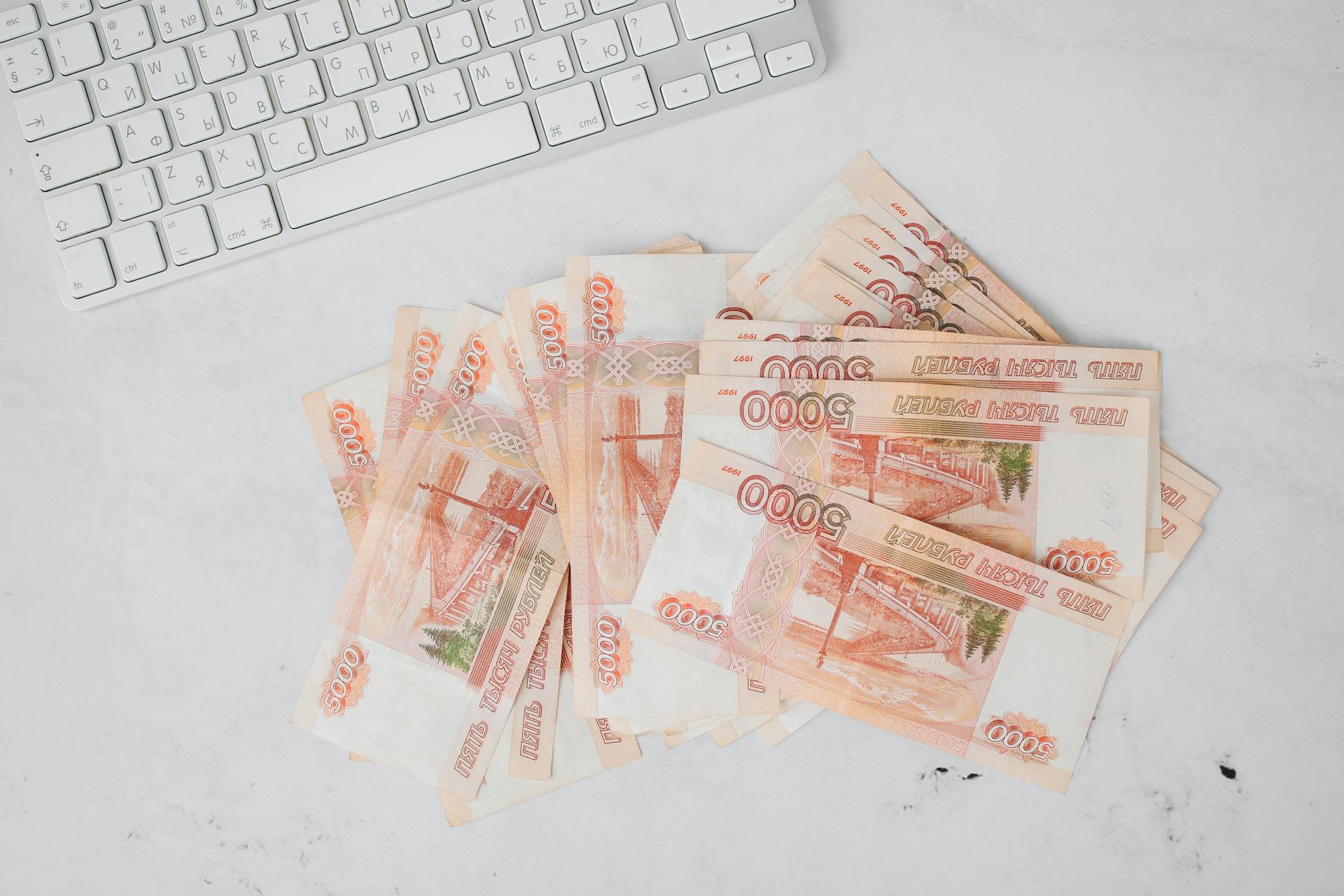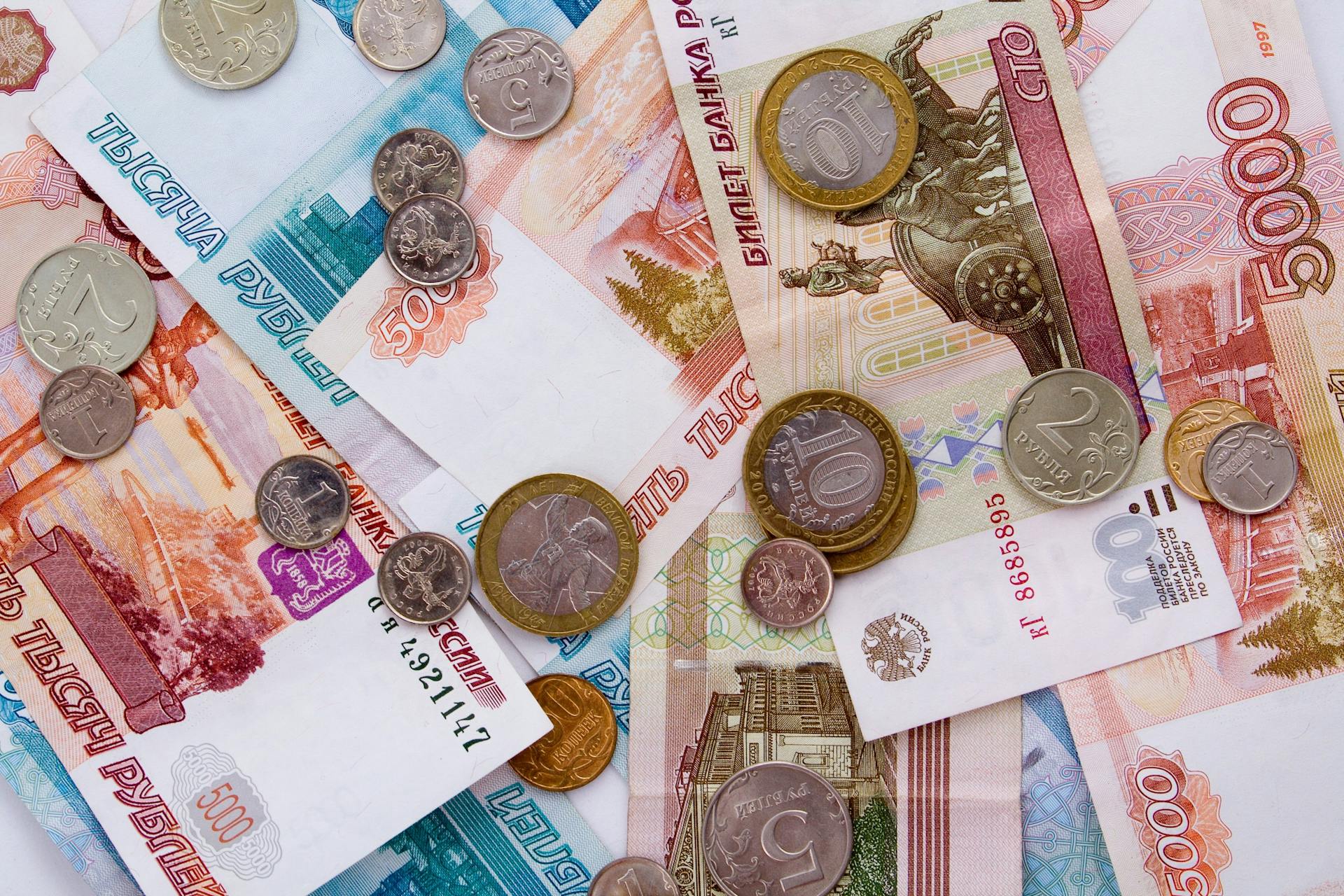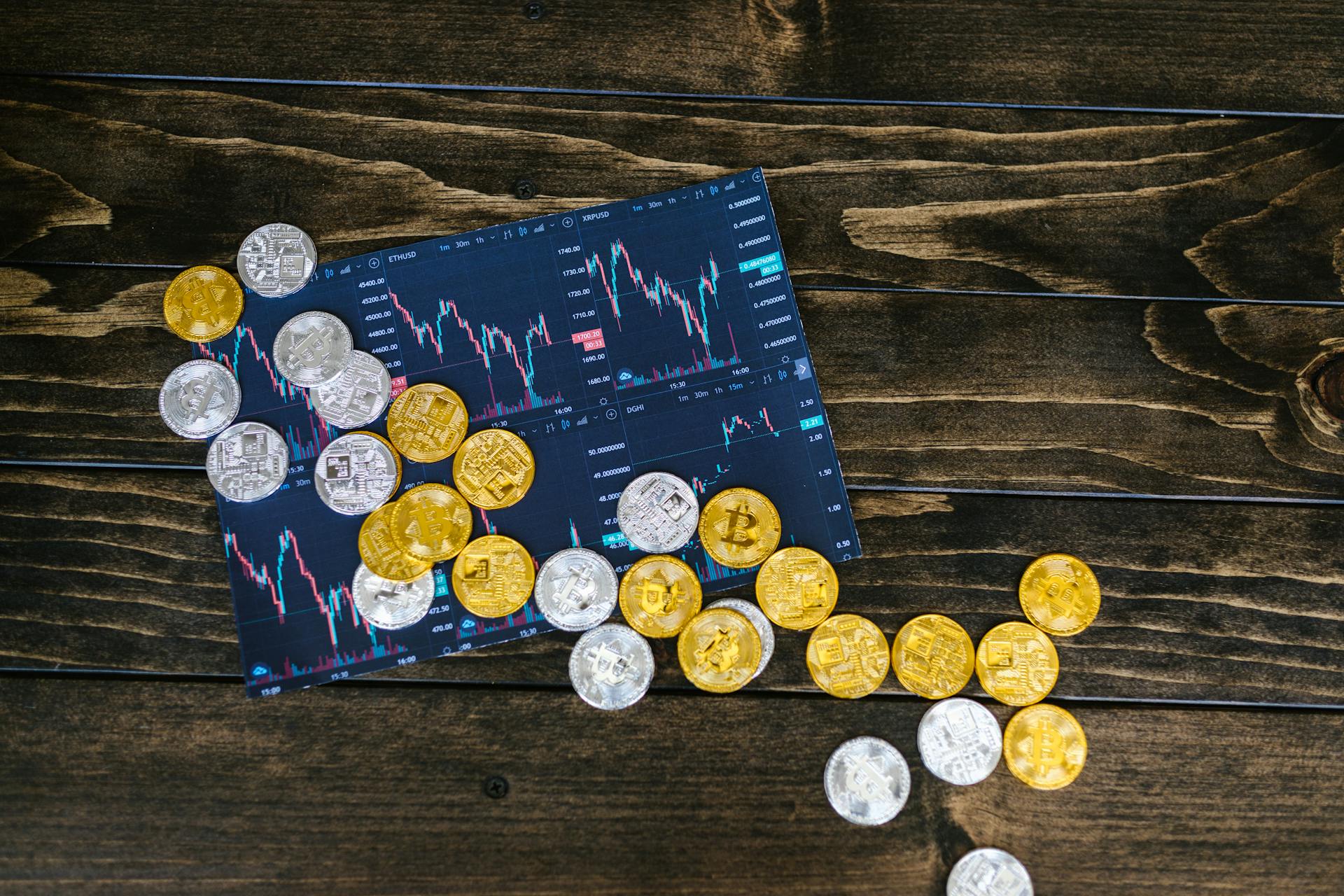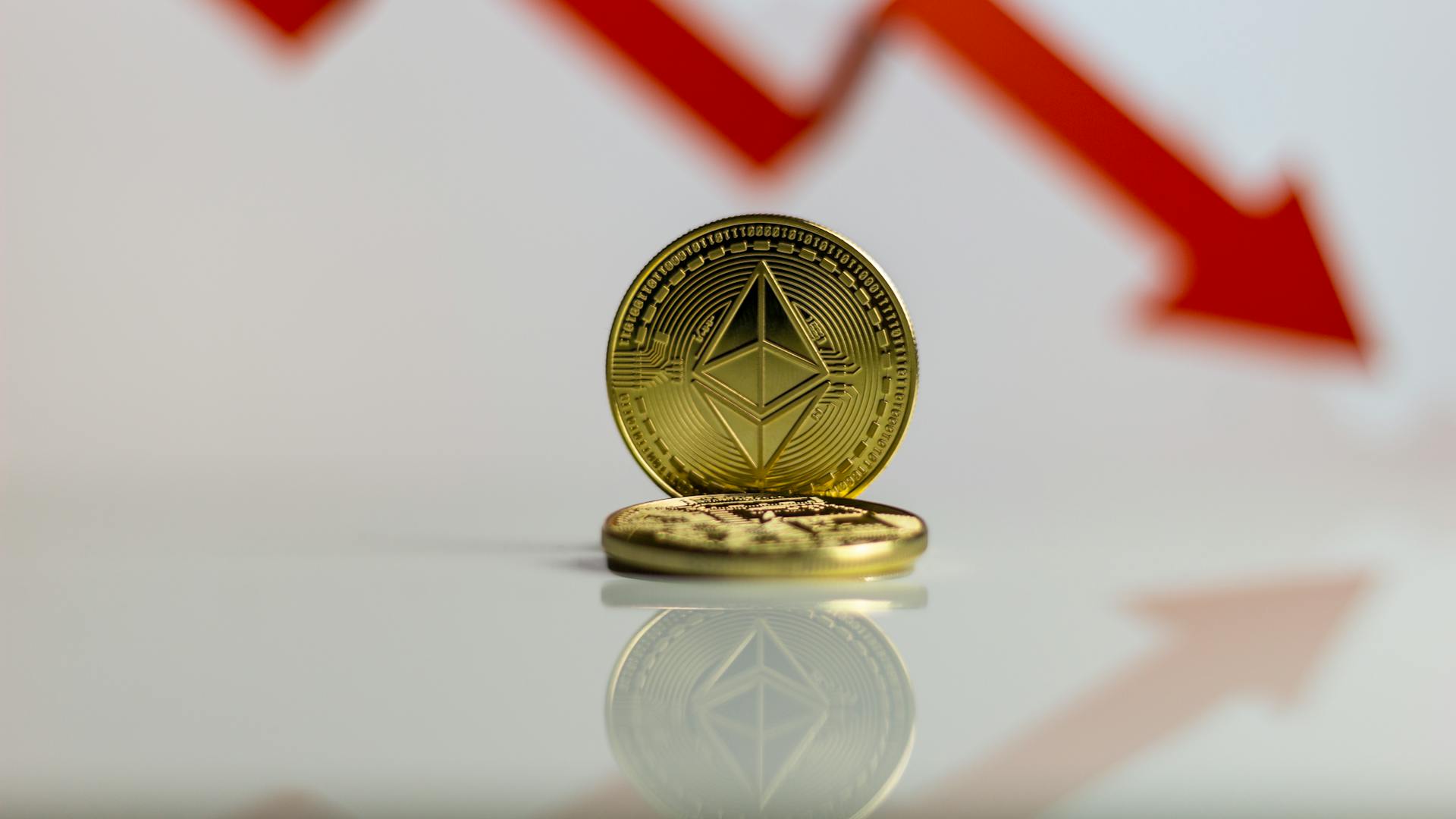
The Russian currency crisis has a long and complex history. In 1998, Russia's economy was on the brink of collapse, with the ruble plummeting in value against the US dollar.
The crisis was triggered by a combination of factors, including a decline in oil prices, a large trade deficit, and a lack of investor confidence in the Russian government's ability to manage the economy.
In August 1998, the Russian government was forced to devalue the ruble and default on its domestic debt, leading to a sharp decline in economic output and a significant increase in poverty rates.
Russia's currency crisis had a devastating impact on the country's economy and its citizens.
Intriguing read: Does Canada Have Their Own Currency
Causes of the Crisis
The Russian currency crisis was a complex event with multiple causes, but some key factors played a significant role.
The fall of the Soviet Union in 1991 led to several years of economic reform, but fundamental institutional weaknesses remained in Russia.
Russia's adoption of a currency peg, which fixed the value of the rouble relative to the dollar, made it difficult to adjust to changing economic conditions.
The Asian financial crisis in 1997 had a ripple effect on Russia, causing investor expectations to change and leading to speculation against the rouble.
In 1995, the IMF made an emergency loan to help Russia stabilize its economy, but it was ultimately unsuccessful.
A global recession and a fall in commodity prices further exacerbated Russia's economic woes, making it difficult for the government to pay its sovereign debts.
The Bank of Russia's attempt to encourage investors by increasing interest rates to 150% ultimately backfired, eroding investor confidence and creating downward pressure on the currency.
Russia's expensive war in Chechnya and weak tax enforcement also contributed to fiscal imbalances and raised questions about the government's ability to maintain a fixed exchange rate.
Background and Events
The Russian currency crisis was a complex event with a rich background. Russia had set up a path for economic improvement after the Soviet Union split into different countries.
In 1997, Russia finally found a way to stop inflation, which was a major concern for the economic supervisors. The ruble devalued when Russia couldn't pay back foreign loans, which had financed domestic investments.
Russia's unemployment rate was relatively low at 13 percent, but this didn't mean the crisis didn't have an impact on employment. The employment policy in Kazakhstan was checked in November 1998 to ensure people had freely chosen employment.
Tajikistan's GDP per capita was one of the lowest after 1996, making it a country heavily affected by the crisis.
Consequences and Recovery
The Russian currency crisis had far-reaching consequences, including a 5.3% contraction of the Russian economy in 1998, with GDP per capita reaching its lowest level since 1991. Inflation soared to 84% due to rouble depreciation, leading to a dramatic fall in real wages and social unrest.
Workers staged strikes and large-scale protests, including demonstrations in front of the Russian White House. This led to increased political instability, with both the prime minister and central bank governor being replaced.
The crisis also had a significant impact on global financial markets, with Russia's sovereign default being the largest in history at the time. This contributed to the collapse of the LTCM hedge fund in the United States, which required a $3.6 billion bailout.
Consequences and Recovery

The Russian economy contracted by 5.3% in 1998 due to the currency crisis and financial market turmoil. This led to a recession and a significant drop in GDP per capita.
In 1998, inflation skyrocketed to 84% due to rouble depreciation, causing a dramatic fall in real wages. This led to social unrest and workers staging strikes and large-scale protests.
The crisis also had a significant impact on international markets, with Russia's sovereign default being the largest in history at the time. This contributed to the collapse of the LTCM hedge fund in the United States, which required a $3.6 billion bailout.
The Russian economy recovered relatively quickly from the 1998 crisis, growing by 6.4% in 1999 and 10% in 2000. This was largely due to the sharp depreciation of the rouble making Russian exports attractive internationally.
The IMF loan of $4.8 billion helped Russia regain access to international financial markets.
Here's an interesting read: Depreciation of a Currency
Financial and Social Impact
The 1998 Russian financial crisis had a profound impact on the country's economy and society. The currency crisis led to a 5.3% contraction of the Russian economy in 1998, with GDP per capita reaching its lowest level since 1991.
Inflation skyrocketed to 84% in 1998 due to rouble depreciation, causing a dramatic fall in real wages. This led to widespread social unrest, with workers staging strikes and large-scale protests.
The crisis also had a significant effect on financial markets globally, with Russia's sovereign default being the largest in history at the time. The collapse of the LTCM hedge fund in the US required a $3.6 billion bailout, causing substantial spillover effects in international markets.
The Russian economy recovered relatively quickly, growing by 6.4% in 1999 and 10% in 2000. This was largely due to the sharp depreciation of the rouble, which made Russian exports attractive internationally.
Economic Factors
The Russian currency crisis was heavily influenced by economic factors. The value of the ruble plummeted due to a significant decline in oil prices, which is Russia's main export.
Russia's economy is heavily reliant on oil exports, with oil accounting for around 60% of the country's export revenue. This made the country highly vulnerable to fluctuations in global oil prices.
As a result, the ruble lost value, making imports more expensive and exacerbating the economic downturn.
See what others are reading: Turkish Economic Crisis (2018–current)
Monetary Policy
In 1998, Russian inflation skyrocketed to 84 percent, making everyday items extremely expensive.
The high inflation rate led to a significant increase in welfare costs, which put a strain on the government's finances.
Many Russian banks, such as Inkombank, Oneximbank, and Tokobank, were forced to close due to the economic crisis.
This collapse of the banking system further exacerbated the economic downturn, making it even harder for people to access basic financial services.
Oil Price Drop
Oil prices started to slide down in February 2014 due to the boom in American shale oil production.
The price of oil fell from $100 per barrel in June 2014 to $60 per barrel in December 2014.
For every $1 decline in crude oil prices, the Russian economy loses billions of dollars. This means a significant loss for Russia's economy.
Russia's economy suffers from Dutch disease, a situation where a country focuses on developing its natural resources to the detriment of other economic activity.

Russia needed an oil price of $100 per barrel to have a balanced budget in 2014.
In August 2015, oil prices fell to US$37 per barrel and then bounced to more than US$45 on 28 August.
Oil prices have started to move up since OPEC reduced production from November 2016, which has also helped the Russian rouble.
If this caught your attention, see: Us Currency vs Chinese Currency
Global Impact
The Russian currency crisis had a significant impact on global financial markets. The Dow Jones Industrial Average declined by nearly 3% in just 3 business days due to the crisis.
U.S. financial markets were not the only ones affected, as other global markets also felt the effects. The crisis drew comparisons to the 1998 Russian financial crisis that had a similar impact on global markets.
The uncertainty caused by Russia's economic crisis led to a decrease in worldwide risk aversion, similar to the Financial crisis of 2007–08. However, the 2014 international sanctions on Russia lowered the risk of an ailing Russian economy affecting the worldwide economy.
Many companies that relied heavily on the Russian economy were affected by the crisis. Ford Motor Company, for example, experienced a 40% decline in car sales in January–November 2014.
Impact on Russia

The impact on Russia was significant. The country's economy suffered greatly due to the global crisis, with a 2.2% decline in GDP in 2020.
Russia's trade relationships were severely affected, with exports decreasing by 10% in the same year. This had a ripple effect on the country's industries, particularly in the energy sector.
The crisis also led to a sharp increase in inflation, which reached 8.8% in 2022. This made it difficult for Russians to afford basic necessities, further exacerbating the economic hardship.
The global crisis had a disproportionate impact on Russia's most vulnerable populations, including low-income families and pensioners.
Impact on Former Soviet Republics
The former Soviet republics, including countries like Ukraine, Russia, and Belarus, have been significantly impacted by global economic events. The annexation of Crimea in 2014 led to a surge in the value of the Russian ruble, with the official USD exchange rate increasing to 0.719.
The economic effects of the annexation were far-reaching, with many countries in the region experiencing a decline in their currency value. For example, the Ukrainian hryvnia (UAH) dropped to 2.8550 from 2.8555, while the Belarusian ruble (BYN) decreased to 0.7843 from 0.7844.
One notable example is the impact on the Ukrainian economy. The annexation of Crimea led to a significant increase in the value of the Russian ruble, making it more expensive for Ukraine to import goods. This, in turn, led to a decline in the value of the Ukrainian hryvnia.
Here's a table showing the official USD exchange rates for some of the former Soviet republics around the time of the annexation:
The economic impact of the annexation was not limited to the short term. The subsequent Ukraine-Russia Gazprom cutoff in June 2014 led to a further decline in the value of the Ukrainian hryvnia, making it even more difficult for the country to recover from the economic shock.
Global Financial Markets
The global financial markets were significantly affected by the Russian financial crisis. The Dow Jones Industrial Average declined nearly 3% in just 3 business days.
One of the main reasons for this decline was the uncertainty caused by Russia's economic crisis, which drew comparisons to the 2007-08 financial crisis. Economist Olivier Blanchard noted that this uncertainty could lead to greater worldwide risk aversion.
The crisis also had a direct impact on financial institutions that held Russian debt or assets. The PIMCO Emerging Markets Bond Fund, for example, saw a 7.9% decline in its holdings of Russian corporate and sovereign debt in just one month.
The Russian financial crisis also had a ripple effect on companies that heavily relied on the Russian economy. American car company Ford Motor Company experienced a 40% decline in car sales, while German car company Volkswagen saw a 20% decline.
In response to the crisis, many financial institutions took steps to limit their exposure to the Russian market. FXCM, a foreign exchange trading service, restricted U.S. dollar-rouble trading due to the volatility of the rouble.
The crisis also had a significant impact on the credit rating of Russia. Ratings agency Standard & Poor's lowered Russia's credit rating to junk status in January 2015, while Moody's followed suit in February 2015.
Related reading: Currency Trading Explained
Expert Insights

Russian currency crisis has been a major concern for many economists. Paul Krugman, a renowned expert, has weighed in on this issue.
Paul Krugman is a Nobel Prize-winning economist known for his insightful commentary on global economic trends. He has a strong track record of predicting economic crises.
Maurice Obstfeld, another prominent economist, has also shared his thoughts on the Russian currency crisis. He has a deep understanding of international finance and monetary policy.
The Russian currency crisis has been a complex issue, with many factors contributing to its severity. Sergei Guriev, a respected economist, has highlighted the importance of understanding the underlying causes of the crisis.
Daniel Triesman, an expert on economic policy, has also provided valuable insights on the Russian currency crisis. His analysis has shed light on the potential consequences of the crisis.
Anders Åslund, a leading expert on Russian economic policy, has a unique perspective on the crisis. His experience working with the Russian government has given him a deep understanding of the country's economic challenges.
Lessons for Today

As we reflect on the Russian currency crisis, one key lesson is that economic instability can have far-reaching consequences.
The crisis was triggered by a sharp decline in oil prices, which accounted for 70% of Russia's export revenue, leaving the country with a significant budget deficit.
The Russian government's decision to devalue the ruble in 2014 led to a surge in imports, exacerbating the crisis.
In the midst of the crisis, the Russian Central Bank raised interest rates to 17%, making borrowing expensive and further straining the economy.
A key takeaway from the crisis is the importance of diversifying a country's economy to reduce dependence on a single export or revenue source.
The crisis highlighted the need for governments to have a well-managed monetary policy in place to mitigate the impact of external shocks.
Russia's experience serves as a reminder that economic crises can have a devastating impact on citizens, particularly those living in poverty.
Central Bank and Sanctions

The Central Bank of Russia played a crucial role in trying to stabilize the rouble during the currency crisis. Despite its efforts, the rouble continued to decline.
The Central Bank had foreign currency reserves worth around $400 billion on 15 December 2014, which gave it the ability to prop up the rouble. However, it spent almost $2 billion in an attempt to strengthen the declining rouble on the same day.
The Central Bank increased its key interest rate from 10.5% to 17% on 16 December 2014, in an attempt to slow or stop the decline of the rouble. This was the sixth increase in interest rates by the Central Bank during 2014.
The Central Bank's intervention had a significant impact, with the rouble declining further to as low as 79 roubles to one U.S. dollar on 16 December 2014.
Central Bank Intervention
On December 15, 2014, the Central Bank of Russia spent almost $2 billion to try and strengthen the declining rouble.

This attempt was just the beginning of a series of interventions by the Central Bank to stabilize the Russian currency. The Central Bank increased its key interest rate from 10.5% to 17% in an attempt to slow or stop the decline of the rouble.
The rouble continued to decline, reaching as low as 79 roubles to one U.S. dollar on December 16, 2014, down from 33 roubles to the dollar in January 2014.
The Central Bank then lent $530 million to Trust Bank, which became the first bank to accept a government bailout during the crisis on December 22, 2014.
In 2015, the Central Bank decreased interest rates numerous times, starting with a cut from 17% to 15% on January 30, 2015.
By June 2015, the interest rate had been lowered to 11.5%, and by July, it was 11%.
Take a look at this: Bank Runs Great Depression
Economic Sanctions
Economic sanctions can have a significant impact on a country's economy. The United States, the European Union, and many other countries imposed economic sanctions on Russia in 2014 following the start of the Russo-Ukrainian War.
These sanctions included Russia's annexation of Crimea and the War in Donbass. International aid to Russia was not considered likely despite the financial crisis.
Economic sanctions can limit a country's access to foreign currency, making it difficult to meet debt obligations. Some Russian oil companies had to exchange their roubles for U.S. dollars or other foreign currencies on the open market to meet their interest payment obligations on their existing debt.
The impact of the international sanctions on the Russian economy was limited by design, affecting only a limited number of individuals and companies. Russian counter-sanctions, however, reduced imports of food into Russia.
As a result, food prices rose, and the average salary decreased. The number of people living under the poverty line increased.
You might like: Russian Foreign Currency Reserves
Frequently Asked Questions
Is the Russian ruble falling in value?
Yes, the Russian ruble has declined sharply in value against the U.S. dollar due to new sanctions targeting over 50 financial institutions, including Gazprombank. This decline is likely to have significant economic implications for Russia.
What is the current economic condition of Russia?
Russia's economy is experiencing a recession, with a sharp drop in imports and falling real incomes, due to ongoing sanctions and reduced government spending. According to the World Bank, this economic downturn is expected to continue in 2023.
Sources
- https://theconversation.com/russian-rouble-collapse-exposes-deep-problems-in-the-countrys-economy-244869
- https://www.economicsobservatory.com/russias-1998-currency-crisis-what-lessons-for-today
- https://www.cnbc.com/2024/11/28/russia-tries-to-stem-panic-over-plummeting-ruble-central-bank-steps-in.html
- https://en.wikipedia.org/wiki/1998_Russian_financial_crisis
- https://en.wikipedia.org/wiki/Russian_financial_crisis_(2014%E2%80%932016)
Featured Images: pexels.com


